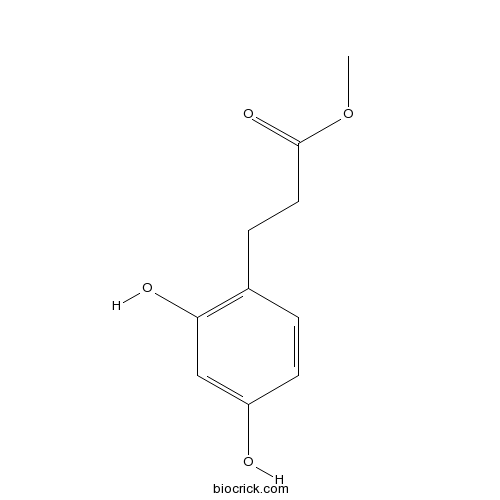Methyl 3-(2,4-dihydroxyphenyl)propionateCAS# 17422-90-1 |

Quality Control & MSDS
3D structure
Package In Stock
Number of papers citing our products

| Cas No. | 17422-90-1 | SDF | Download SDF |
| PubChem ID | 12112140 | Appearance | Oil |
| Formula | C10H12O4 | M.Wt | 196.2 |
| Type of Compound | Phenylpropanoids | Storage | Desiccate at -20°C |
| Solubility | Soluble in Chloroform,Dichloromethane,Ethyl Acetate,DMSO,Acetone,etc. | ||
| Chemical Name | methyl 3-(2,4-dihydroxyphenyl)propanoate | ||
| SMILES | COC(=O)CCC1=C(C=C(C=C1)O)O | ||
| Standard InChIKey | AGDUPZONPGNRJL-UHFFFAOYSA-N | ||
| Standard InChI | InChI=1S/C10H12O4/c1-14-10(13)5-3-7-2-4-8(11)6-9(7)12/h2,4,6,11-12H,3,5H2,1H3 | ||
| General tips | For obtaining a higher solubility , please warm the tube at 37 ℃ and shake it in the ultrasonic bath for a while.Stock solution can be stored below -20℃ for several months. We recommend that you prepare and use the solution on the same day. However, if the test schedule requires, the stock solutions can be prepared in advance, and the stock solution must be sealed and stored below -20℃. In general, the stock solution can be kept for several months. Before use, we recommend that you leave the vial at room temperature for at least an hour before opening it. |
||
| About Packaging | 1. The packaging of the product may be reversed during transportation, cause the high purity compounds to adhere to the neck or cap of the vial.Take the vail out of its packaging and shake gently until the compounds fall to the bottom of the vial. 2. For liquid products, please centrifuge at 500xg to gather the liquid to the bottom of the vial. 3. Try to avoid loss or contamination during the experiment. |
||
| Shipping Condition | Packaging according to customer requirements(5mg, 10mg, 20mg and more). Ship via FedEx, DHL, UPS, EMS or other couriers with RT, or blue ice upon request. | ||
| Description | 1. Methyl 3-(2,4-dihydroxyphenyl)propionate has inhibitory effects on tyrosinase, antioxidant ability, and lightening effect of ultraviolet B (UVB)-induced hyperpigmentation. |

Methyl 3-(2,4-dihydroxyphenyl)propionate Dilution Calculator

Methyl 3-(2,4-dihydroxyphenyl)propionate Molarity Calculator
| 1 mg | 5 mg | 10 mg | 20 mg | 25 mg | |
| 1 mM | 5.0968 mL | 25.4842 mL | 50.9684 mL | 101.9368 mL | 127.421 mL |
| 5 mM | 1.0194 mL | 5.0968 mL | 10.1937 mL | 20.3874 mL | 25.4842 mL |
| 10 mM | 0.5097 mL | 2.5484 mL | 5.0968 mL | 10.1937 mL | 12.7421 mL |
| 50 mM | 0.1019 mL | 0.5097 mL | 1.0194 mL | 2.0387 mL | 2.5484 mL |
| 100 mM | 0.051 mL | 0.2548 mL | 0.5097 mL | 1.0194 mL | 1.2742 mL |
| * Note: If you are in the process of experiment, it's necessary to make the dilution ratios of the samples. The dilution data above is only for reference. Normally, it's can get a better solubility within lower of Concentrations. | |||||

Calcutta University

University of Minnesota

University of Maryland School of Medicine

University of Illinois at Chicago

The Ohio State University

University of Zurich

Harvard University

Colorado State University

Auburn University

Yale University

Worcester Polytechnic Institute

Washington State University

Stanford University

University of Leipzig

Universidade da Beira Interior

The Institute of Cancer Research

Heidelberg University

University of Amsterdam

University of Auckland

TsingHua University

The University of Michigan

Miami University

DRURY University

Jilin University

Fudan University

Wuhan University

Sun Yat-sen University

Universite de Paris

Deemed University

Auckland University

The University of Tokyo

Korea University
- 3-Chloro-4-hydroxypiperidin-2-one
Catalog No.:BCN3992
CAS No.:174204-83-2
- Aristolochic acid D
Catalog No.:BCN2902
CAS No.:17413-38-6
- 3-(4-Pyridyl)-D-Alanine.2HCl
Catalog No.:BCC2650
CAS No.:174096-41-4
- Tomatine
Catalog No.:BCN2966
CAS No.:17406-45-0
- Bevirimat
Catalog No.:BCC5312
CAS No.:174022-42-5
- Dehydroabietic acid
Catalog No.:BCN1119
CAS No.:1740-19-8
- Nepicastat
Catalog No.:BCC1795
CAS No.:173997-05-2
- 5-Acetyl-6-hydroxy-2-(1-hydroxy-1-methylethyl)benzofuran
Catalog No.:BCN7495
CAS No.:173992-05-7
- 22-Hydroxy-3-oxo-12-ursen-30-oic acid
Catalog No.:BCN1526
CAS No.:173991-81-6
- Tanshinone IIB
Catalog No.:BCN1118
CAS No.:17397-93-2
- SYM 2206
Catalog No.:BCC6866
CAS No.:173952-44-8
- Isogambogenin
Catalog No.:BCN3066
CAS No.:173938-23-3
- Pancixanthone A
Catalog No.:BCN7379
CAS No.:174232-30-5
- Apigenin 7-O-(2G-rhamnosyl)gentiobioside
Catalog No.:BCN1524
CAS No.:174284-20-9
- Epimedin K
Catalog No.:BCN8201
CAS No.:174286-13-6
- Caohuoside E
Catalog No.:BCN8198
CAS No.:174286-23-8
- Astragaloside
Catalog No.:BCN5959
CAS No.:17429-69-5
- Picropodophyllotoxin
Catalog No.:BCN2585
CAS No.:17434-18-3
- Tsugaric acid A
Catalog No.:BCN2980
CAS No.:174391-64-1
- Riluzole
Catalog No.:BCC3849
CAS No.:1744-22-5
- Amiloride HCl dihydrate
Catalog No.:BCC5068
CAS No.:17440-83-4
- Sanggenol A
Catalog No.:BCN3602
CAS No.:174423-30-4
- Tipranavir
Catalog No.:BCC2002
CAS No.:174484-41-4
- alpha-Spinasterol glucoside
Catalog No.:BCN1120
CAS No.:1745-36-4
Novel vitamin E derivative with 4-substituted resorcinol moiety has both antioxidant and tyrosinase inhibitory properties.[Pubmed:11834083]
Lipids. 2001 Dec;36(12):1321-6.
A novel vitamin E derivative, (6"-hydroxy-2",5",7",8"-tetramethylchroman-2"-yl)methyl 3-(2',4'-dihydroxyphenyl)propionate (TM4R), which has a chromanoxyl ring and 4-substituted resorcinol moieties, was synthesized; and its inhibitory effects on tyrosinase, antioxidant ability, and lightening effect of ultraviolet B (UVB)-induced hyperpigmentation were estimated. TM4R showed potent inhibitory activity on tyrosinase, which is the rate-limiting enzyme in melanogenesis. The scavenging activities of TM4R on 1,1-diphenyl-2-picrylhydrazyl and hydroxyl radicals were found to be nearly the same as those of alpha-tocopherol. Furthermore, an efficient lightening effect was observed following topical application of TM4R to UVB-stimulated hyperpigmented dorsal skin of brownish guinea pigs. These results suggest that TM4R may be a candidate for an efficient whitening agent, possibly by inhibiting tyrosinase activity and biological reactions caused by reactive oxygen species.


